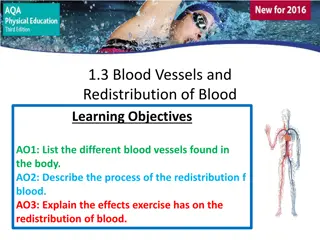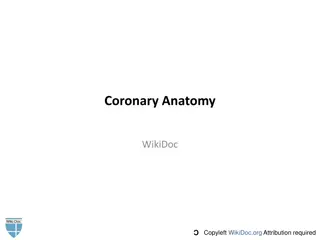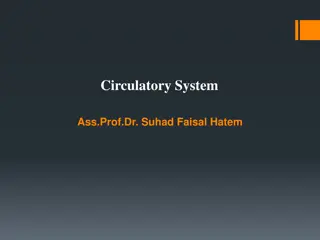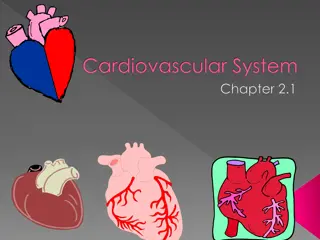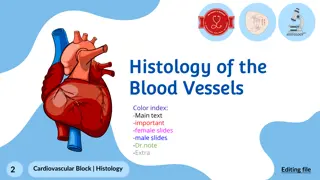Anatomy of the Larynx, Trachea, and Bronchi: Respiratory System Overview
The larynx, trachea, and bronchi are vital structures of the respiratory system with distinct functions and anatomy. The larynx houses vocal cords, aids in breathing, voice production, and swallowing. It is interconnected with major arteries, veins, and nerves in the neck. The trachea extends from t
12 views • 19 slides
Urban Development Models: Burgess and Hoyt
The Burgess concentric ring model and Hoyt sector model are key frameworks explaining urban social structures. Burgess's model illustrates urban land use in rings around the CBD, while Hoyt's model emphasizes outward growth along transportation arteries. Criticisms include applicability limitations
5 views • 13 slides
Understanding Cardiac Rehabilitation and Physiotherapy Approaches
Explore the comprehensive agenda covering topics like the general structure of the circulatory system, blood circulation in the human body, risk factors for cardiovascular diseases, and physiotherapeutic approaches in cardiac rehabilitation. Gain insights into the anatomy of the heart, arteries, vei
6 views • 14 slides
Cardiologist In Jaipur-Dr Rahul Sharma
Angina Symptoms: Angina is a condition characterized by chest pain or discomfort caused by reduced blood flow to the heart muscle. It\u2019s often a symptom of underlying coronary artery disease, which occurs when the arteries that supply blood to the heart become narrowed or blocked by plaque build
1 views • 6 slides
Understanding the Blood Supply of the Brain
The brain receives its blood supply from four major arteries - two vertebral arteries and two internal carotid arteries. The vertebral arteries branch into the basilar artery, which gives rise to various important branches. The internal carotid arteries supply the anterior and middle cerebral arteri
1 views • 30 slides
Understanding the Circulatory System in Animals and Plants
Transportation in animals and plants involves the movement of food, water, gases, and waste products through a circulatory system. Blood, a vital fluid connective tissue, carries out these functions by transporting essential substances like oxygen, nutrients, and waste products. The circulatory syst
0 views • 14 slides
Understanding the Circulatory System: A Detailed Overview
The circulatory system plays a vital role in transporting nutrients, oxygen, and other essential substances throughout the body. It consists of the blood vascular system (arteries, arterioles, veins, capillaries, and the heart) and the lymphatic vascular system. Understanding the general structure o
0 views • 31 slides
Understanding Blood Vessels and Circulation in the Body
Explore the intricate network of blood vessels in the body, including arteries, veins, and capillaries. Learn about the process of blood redistribution and the impact of exercise on circulation. Understand the vital role of the circulatory system in maintaining overall health and physical performanc
0 views • 14 slides
Understanding Heart Health: A Comprehensive Guide
Explore the critical roles of the aorta, pulmonary artery, and coronary arteries in heart function. Discover the impact of a blocked coronary artery and learn about treatments for coronary heart disease. Delve into common heart problems, like leaky valves and irregular heartbeat, and how innovations
0 views • 15 slides
Understanding Coronary Circulation and Arterial Supply in Cardiovascular Physiology
Explore the intricate details of coronary circulation, including arterial supply, branches of coronary arteries, and areas of distribution. Dr. Abeer Al-Masri, an Associate Professor and Cardiovascular Physiologist at the Faculty of Medicine, KSU, provides valuable insights on the topic, covering th
1 views • 30 slides
Anatomy of Paravertebral Region and Root of Neck
This informative content presents the paravertebral region and the muscles of the neck, including the scalene muscles (posterior, medius, and anterior). It covers the origin, insertion, nerve supply, and actions of these muscles, providing a clear understanding of their functions. Additionally, it d
0 views • 18 slides
Understanding Gangrene: Causes, Types, and Symptoms
Gangrene is a severe condition characterized by tissue necrosis, often due to loss of blood supply or bacterial infections. It is classified into dry, moist, and gas gangrene based on various factors like blood supply and fluid loss. Dry gangrene, also known as mummification, typically affects extre
0 views • 10 slides
Impact of Diet on Cardiovascular Health
The impact of diet on the cardiovascular system is significant, with a high intake of LDL leading to clogged arteries and increased risk of Coronary Heart Disease. Regular exercise brings about positive changes in the cardiovascular system, enhancing heart function and oxygen delivery. Immediate ben
0 views • 7 slides
Understanding the Circulatory System and Blood Vessels in Histology
The circulatory system, comprising the cardiovascular and lymphatic systems, plays a vital role in transporting essential substances throughout the body. It consists of arteries, veins, capillaries, and the heart. Blood vessels have distinct histological structures with three main layers - intima, m
1 views • 15 slides
Exploring the Components of the Circulatory System
The circulatory system, comprising the heart, blood vessels, and various components like arteries, veins, and capillaries, plays a crucial role in distributing oxygen, nutrients, and waste products throughout the body. The heart pumps blood through a double circulatory system, ensuring oxygenation o
0 views • 4 slides
Understanding the Impact of Nutrition on Coronary Heart Disease
Explore the relationship between nutrition and coronary heart disease through images depicting blood cholesterol levels, food pyramids for both healthy individuals and those with high cholesterol, and methods to increase fiber in your diet. Understand how cholesterol buildup in arteries can lead to
0 views • 13 slides
Understanding Coronary Artery Anatomy and Dominance
Explore the intricate details of coronary artery anatomy with a focus on the right and left coronary arteries, as well as variations such as large right dominance, small right dominance, co-dominance, and left dominance. Learn about the importance of understanding these structures in relation to car
0 views • 8 slides
Understanding the Cardiovascular System: An Overview
The cardiovascular system, comprising the heart and blood vessels, plays a vital role in delivering oxygen and nutrients to body tissues. Arteries carry oxygenated blood away from the heart, veins transport deoxygenated blood back to the heart, and capillaries facilitate nutrient exchange. Learn abo
0 views • 21 slides
Understanding the Complexity of Human Anatomy in Cardiovascular Health
Explore the intricate organization of human tissues within arteries and veins, and uncover the vital roles they play in maintaining cardiovascular function. Learn about specific tissues such as collagen, muscle, and endothelium, and their significance in preventing diseases and regulating blood flow
0 views • 50 slides
Understanding High Blood Pressure: Causes, Risks, and Management
High blood pressure, or hypertension, is a condition where the blood exerts elevated force against artery walls, leading to increased heart workload and potential damage to arteries. It poses risks for heart disease, stroke, and kidney issues. Pre-hypertension and danger zones indicate different sta
1 views • 15 slides
Understanding the Circulatory System: Functions and Components
The circulatory system, comprised of pulmonary and systemic circulation, plays a crucial role in transporting oxygen, nutrients, and waste products throughout the body. It consists of the heart, arteries, veins, and capillaries which work together to ensure proper circulation. Blood, the carrier of
0 views • 21 slides
Overview of the Cardiovascular System and Arterial Blood Vessels
The cardiovascular system includes the heart, arteries, veins, and capillaries, responsible for the transport of blood and lymph throughout the body. Arterial blood vessels are classified based on diameter into large (elastic) arteries, medium (muscular) arteries, and arterioles. The arterial wall c
0 views • 13 slides
Understanding the Heart and Circulatory System in Science
Explore the key concepts of the heart and circulatory system, including the functions of arteries, veins, and capillaries. Learn about how the heart pumps oxygenated and deoxygenated blood, the role of valves, and the circulation process. Dive into engaging animations and resources to enhance your u
0 views • 6 slides
Understanding the Cardiovascular System: An Overview
The cardiovascular system, comprised of the heart, blood vessels, and blood, plays a vital role in circulating nutrients, oxygen, and waste throughout the body. This summary provides insights into the structure and function of the heart's chambers, blood flow through the circulatory system, and the
0 views • 17 slides
Anatomy Review: Large Intestine and Rectum Histology
The presentation delves into the detailed morphology and histology of the large intestine and rectum, covering aspects often not emphasized in textbooks. It explores nuances such as the S-shaped structure of the rectum, the composition of the anal canal, the layers of epithelium, and the territorial
1 views • 8 slides
Understanding Carotid Endarterectomy: A Comprehensive Overview
Carotid endarterectomy is a crucial vascular operation aimed at improving outcomes for patients at risk of stroke. This procedure targets the removal of plaque build-up in the carotid arteries to prevent further cerebrovascular events. The surgery's effectiveness is highlighted by its impact on redu
0 views • 12 slides
Understanding Arterial Blood Gases and Oxygen Delivery Devices
Arterial blood gases (ABG) are obtained from arteries to assess acid-base balance and blood oxygen levels. The pH, PaCO2, PaO2, HCO3, and SaO2 are crucial values on an ABG report. These values reflect the blood's acid-base status, carbon dioxide levels, oxygen saturation, and more. The buffer system
0 views • 25 slides
Understanding the Impact of High Blood Pressure on the Body
High blood pressure, or hypertension, is a common condition that can lead to serious health complications such as heart disease, stroke, and kidney damage. This article explores the effects of high blood pressure on various organs in the body, including the brain, heart, kidneys, eyes, and arteries.
0 views • 25 slides
Medical Case Study: Jiao, a 74-Year-Old Chinese Woman with Myocardial Infarction
Jiao, a 74-year-old Chinese woman, was admitted to the hospital with chest pain and diagnosed with a mild myocardial infarction. She needed surgery due to severe plaque buildup in her coronary arteries. High cholesterol levels led to a restricted diet plan. Language barrier challenges arose when the
0 views • 5 slides
Microscopic Structure of Blood Vessels and Their Layers
The lecture covers the microscopic structure of the wall of blood vessels including large veins, elastic arteries, muscular arteries, and blood capillaries. The three concentric layers of blood vessel walls are discussed, which include the tunica intima, tunica media, and tunica adventitia. Detailed
0 views • 11 slides
Comprehensive Learning Session on Tibia Anatomy
Explore the intricate details of tibia anatomy in this educational presentation by Dr. Untika Singh from King George's Medical University. Learn to identify the tibia, understand its different parts, surfaces, and attachment points, and grasp its significance as a weight-bearing bone in the leg. Div
0 views • 25 slides
Understanding Heart Disease: Causes, Symptoms, and Common Conditions
Heart disease, a prevalent health issue in the United States, encompasses various cardiovascular conditions like coronary artery disease and hypertension. It is a leading cause of death, often resulting from conditions that can lead to heart attacks or failure. Symptoms of heart conditions vary, fro
0 views • 28 slides
Understanding the Structures of the Heart and Its Arteries
Explore the key structures of the heart, including arteries like the pulmonary artery, aorta, and coronary arteries. Learn how these blood vessels function to ensure oxygenated blood is efficiently transported to different parts of the body. Visual aids included.
0 views • 5 slides
Understanding Small Bowel Anatomy and Barium Meal Technique
Exploring the anatomy of the small bowel, including the duodenum, jejunum, and ileum, as well as the technique of a barium meal follow-through. The small bowel is a convoluted tube extending from the pylorus to the ileocecal valve, averaging 6-7 meters in length. The duodenum, characterized by its C
0 views • 34 slides
Surgical Approaches to Foramen Magnum Lesions: Anatomy and Considerations
Surgical approaches to foramen magnum lesions involve understanding the anatomical structures, diameters, condyles, and contents of the region. Critical considerations include the choice of surgical approach based on the location and extent of the lesion, size, and nature of the pathology. Approache
0 views • 53 slides
Understanding Arteries: Anatomy and Function Overview
Explore the key concepts related to arteries, including their definition, anastomosis, end arteries, aorta divisions, and major artery distribution in the body. Learn about the general principles of arteries and their role in blood circulation, emphasizing the importance of anastomoses. Dive into th
0 views • 21 slides
Understanding the Cardiovascular System: Anatomy, Physiology, and Function
Explore the intricate workings of the cardiovascular system, encompassing the heart, blood vessels, and blood circulation. Learn the anatomy, physiology, and function of this vital system, including the roles of arteries, veins, capillaries, and red and blue blood. Understand how the cardiovascular
0 views • 23 slides
Understanding Atherosclerosis: Causes, Symptoms, and Prevention
Arteriosclerosis and atherosclerosis are common cardiovascular conditions that involve the hardening and narrowing of arteries due to plaque buildup. Atherosclerosis specifically refers to the accumulation of fats and cholesterol in artery walls, leading to restricted blood flow and potential compli
0 views • 24 slides
Understanding Blood Vessels and Their Role in the Body
Blood vessels are a crucial part of the circulatory system, comprising arteries, veins, and capillaries. Arteries carry oxygenated blood away from the heart, veins transport deoxygenated blood back to the heart with the help of valves, and capillaries act as connectors between arteries and veins, fa
0 views • 5 slides
Overview of Carpal Bones and Carpal Tunnel Anatomy
Carpal bones are arranged in two rows with distinct features such as the flexor retinaculum and extensor retinaculum that form the carpal tunnel. Radiological features and nutrient arteries of the scaphoid bone are crucial in understanding carpal anatomy. Ossification of the carpal bones occurs in a
0 views • 13 slides







